A Report on the IMF's Response to the 2008 Global Financial Crisis
VerifiedAdded on 2022/03/10
|11
|3077
|21
Report
AI Summary
This report examines the International Monetary Fund's (IMF) response to the 2008 global financial crisis, highlighting its shift to the center of international economic governance after a period of declining influence. The analysis covers the causes of the crisis, including the collapse of Lehman Brothers and the subprime mortgage crisis in the U.S., and details the IMF's actions, such as providing substantial loans and coordinating international initiatives. The report discusses various scholars' arguments regarding the failures of international economic governance and the IMF's pre-crisis surveillance, which did not foresee the crisis. It analyzes the IMF's rapid response to affected nations, including Hungary, Romania, and Ukraine, and the establishment of new lending facilities. The report also examines the criticisms of the IMF's role, including its failure to predict the crisis and its initial support for policies that contributed to it. The report includes the arguments of different scholars regarding the effectiveness of the IMF's actions and the overall management of the crisis, providing a comprehensive overview of the IMF's involvement and its impact on the global economy.
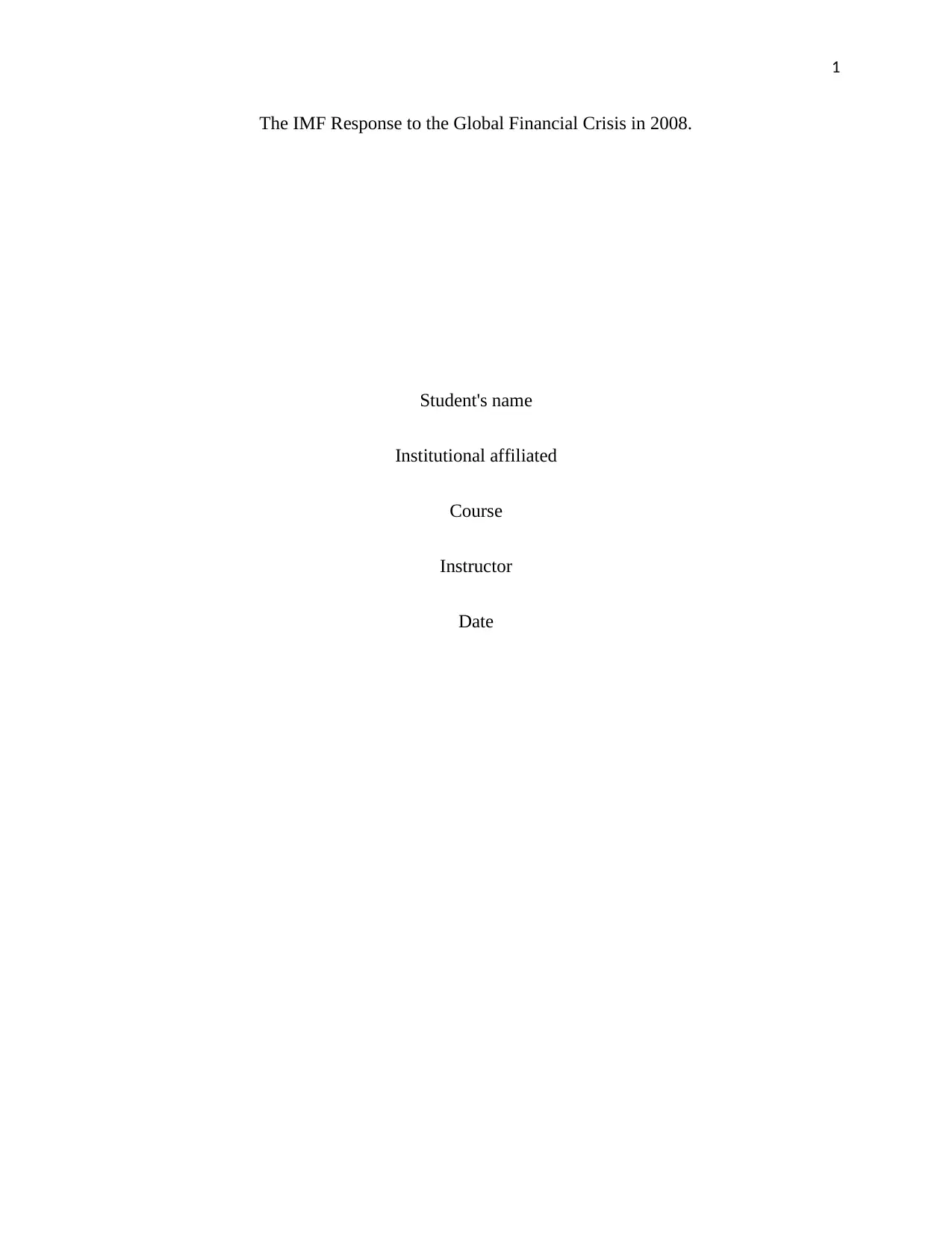
1
The IMF Response to the Global Financial Crisis in 2008.
Student's name
Institutional affiliated
Course
Instructor
Date
The IMF Response to the Global Financial Crisis in 2008.
Student's name
Institutional affiliated
Course
Instructor
Date
Paraphrase This Document
Need a fresh take? Get an instant paraphrase of this document with our AI Paraphraser

2
The IMF Response to the Global Financial Crisis in 2008.
The international financial catastrophe of 2008 dramatically affected the International
Monetary Fund, moving it down to the center phase of worldwide financial control after a period
where it had lost lawfulness and significance. The beginning of the worldwide financial disaster
was the main test of the International Monetary Fund's significance and role in the international
economy and international economic governance. Before the disaster exploded in September
2008, most individuals suggested that the IMF was losing significance and credibility. Its rate of
lending was depreciating, and its staff was reducing. The calamity suddenly changed the IMF,
infiltrating it with new life and relevance as the centerpiece of worldwide economic governance
(Rodriguez, 2017). The G20 influencers looked up to the IMF to be a monetary firefighter and
agreed on a sudden increase of IMF loaning finances up to $750 billion. IMF finances had gotten
almost $1trillion by 2013. The organization moving back to the center phase in international
monetary governance at the onset of the worldwide monetary disaster was not the outcome of its
excellent pre-disaster conduct but the fact that IMF was the correct organization in the exact
place at the precise moment. Even after overseeing for more than a century state and worldwide
financial affairs, the main financial organization responsible for maintaining economic stability
worldwide, IMF was unable to forecast and control the worst disaster fully since the 1930s. The
paper will summarise the 2008 global crisis, the IMF response to the global crisis, various
scholars' argument about the international crisis, and the credibility of the IMF response to the
global crisis.
In September 2008, the international financial crisis blew up, caused by the downfall of the
Lehman Brothers, which shocked worldwide markets and started monetary panic as credit
markets seized up, leading to unemployment and economic disaster. A mortgage disaster
The IMF Response to the Global Financial Crisis in 2008.
The international financial catastrophe of 2008 dramatically affected the International
Monetary Fund, moving it down to the center phase of worldwide financial control after a period
where it had lost lawfulness and significance. The beginning of the worldwide financial disaster
was the main test of the International Monetary Fund's significance and role in the international
economy and international economic governance. Before the disaster exploded in September
2008, most individuals suggested that the IMF was losing significance and credibility. Its rate of
lending was depreciating, and its staff was reducing. The calamity suddenly changed the IMF,
infiltrating it with new life and relevance as the centerpiece of worldwide economic governance
(Rodriguez, 2017). The G20 influencers looked up to the IMF to be a monetary firefighter and
agreed on a sudden increase of IMF loaning finances up to $750 billion. IMF finances had gotten
almost $1trillion by 2013. The organization moving back to the center phase in international
monetary governance at the onset of the worldwide monetary disaster was not the outcome of its
excellent pre-disaster conduct but the fact that IMF was the correct organization in the exact
place at the precise moment. Even after overseeing for more than a century state and worldwide
financial affairs, the main financial organization responsible for maintaining economic stability
worldwide, IMF was unable to forecast and control the worst disaster fully since the 1930s. The
paper will summarise the 2008 global crisis, the IMF response to the global crisis, various
scholars' argument about the international crisis, and the credibility of the IMF response to the
global crisis.
In September 2008, the international financial crisis blew up, caused by the downfall of the
Lehman Brothers, which shocked worldwide markets and started monetary panic as credit
markets seized up, leading to unemployment and economic disaster. A mortgage disaster

3
originating in America changed into a full-blown catastrophe, which afterwards spread beyond
American borders, becoming an international economic disaster. The foundation of the
international calamity was in subprime covering credit disaster in America, itself led by
appreciating housing charges, apparently constant temporary interest charges, accessibility of
easy-to-get advances even for extreme risk debtors, and feeble controlling misunderstanding.
Mortgages were securitized, causing dangerous tools. When interest rates began appreciating,
individuals began defaulting on mortgages, the sale of houses depreciated, and the bubble busted.
Weak rules played a part in the breakdown. In America, there was no actual effort to solve the
housing fizz. The European central bankers did not respond to a flow in requesting loans. Global
wealth ratios for banks were also feeble. Banks could escape withholding nominal principal
aside. They were also skilful at shifting debt off-balance sheets or performing other imaginative
finances to enable them to carry on more loans. Lehman was the earliest and one of the biggest
investment banks in America, with 25000 workers and $600 billion assets. The subprime
mortgage disaster highly impacted it, and its stock had declined sharply in value throughout the
year. Its collapse was one of the biggest in history. The American treasury and federal reserve
decision to let Lehman collapse remains controversial because it did not hinder the financial
breakdown. Soon after, the fed extended a lot of money to support the sale of securities firm Bear
Stearns to JPMorgan Chase.
The subsequent "Great Recession" was the worst the universe had encountered since the 1930s
Great Depression and caused massive pressure on prevailing attempts to more international
economic authority. Capital flows were all drained, trade decreased dramatically, and the rate of
joblessness increased in the following months. The worldwide economic development of 1.9% in
2008 skimmed into a reduction of 2.1% the subsequent year, which signified the first
originating in America changed into a full-blown catastrophe, which afterwards spread beyond
American borders, becoming an international economic disaster. The foundation of the
international calamity was in subprime covering credit disaster in America, itself led by
appreciating housing charges, apparently constant temporary interest charges, accessibility of
easy-to-get advances even for extreme risk debtors, and feeble controlling misunderstanding.
Mortgages were securitized, causing dangerous tools. When interest rates began appreciating,
individuals began defaulting on mortgages, the sale of houses depreciated, and the bubble busted.
Weak rules played a part in the breakdown. In America, there was no actual effort to solve the
housing fizz. The European central bankers did not respond to a flow in requesting loans. Global
wealth ratios for banks were also feeble. Banks could escape withholding nominal principal
aside. They were also skilful at shifting debt off-balance sheets or performing other imaginative
finances to enable them to carry on more loans. Lehman was the earliest and one of the biggest
investment banks in America, with 25000 workers and $600 billion assets. The subprime
mortgage disaster highly impacted it, and its stock had declined sharply in value throughout the
year. Its collapse was one of the biggest in history. The American treasury and federal reserve
decision to let Lehman collapse remains controversial because it did not hinder the financial
breakdown. Soon after, the fed extended a lot of money to support the sale of securities firm Bear
Stearns to JPMorgan Chase.
The subsequent "Great Recession" was the worst the universe had encountered since the 1930s
Great Depression and caused massive pressure on prevailing attempts to more international
economic authority. Capital flows were all drained, trade decreased dramatically, and the rate of
joblessness increased in the following months. The worldwide economic development of 1.9% in
2008 skimmed into a reduction of 2.1% the subsequent year, which signified the first
⊘ This is a preview!⊘
Do you want full access?
Subscribe today to unlock all pages.

Trusted by 1+ million students worldwide
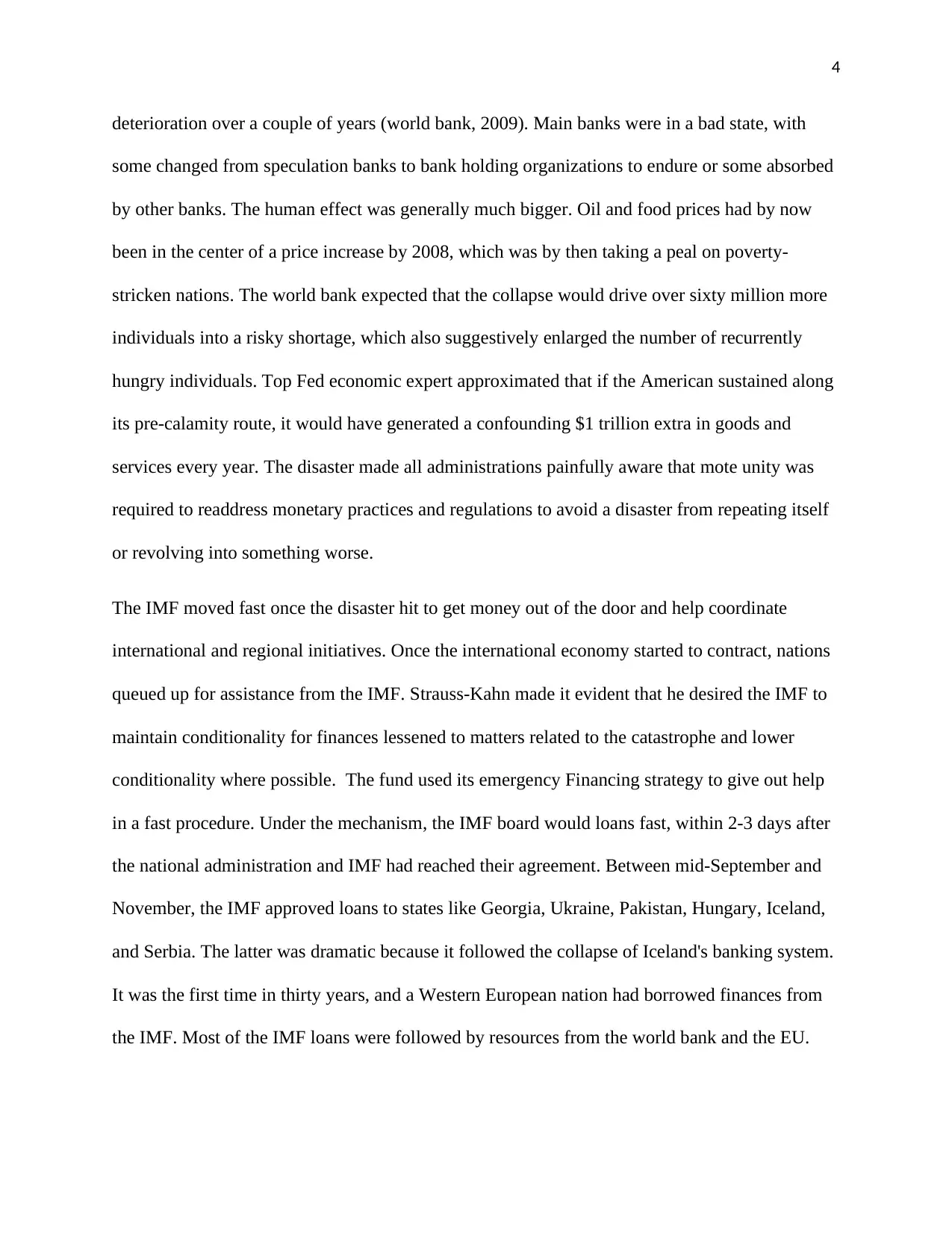
4
deterioration over a couple of years (world bank, 2009). Main banks were in a bad state, with
some changed from speculation banks to bank holding organizations to endure or some absorbed
by other banks. The human effect was generally much bigger. Oil and food prices had by now
been in the center of a price increase by 2008, which was by then taking a peal on poverty-
stricken nations. The world bank expected that the collapse would drive over sixty million more
individuals into a risky shortage, which also suggestively enlarged the number of recurrently
hungry individuals. Top Fed economic expert approximated that if the American sustained along
its pre-calamity route, it would have generated a confounding $1 trillion extra in goods and
services every year. The disaster made all administrations painfully aware that mote unity was
required to readdress monetary practices and regulations to avoid a disaster from repeating itself
or revolving into something worse.
The IMF moved fast once the disaster hit to get money out of the door and help coordinate
international and regional initiatives. Once the international economy started to contract, nations
queued up for assistance from the IMF. Strauss-Kahn made it evident that he desired the IMF to
maintain conditionality for finances lessened to matters related to the catastrophe and lower
conditionality where possible. The fund used its emergency Financing strategy to give out help
in a fast procedure. Under the mechanism, the IMF board would loans fast, within 2-3 days after
the national administration and IMF had reached their agreement. Between mid-September and
November, the IMF approved loans to states like Georgia, Ukraine, Pakistan, Hungary, Iceland,
and Serbia. The latter was dramatic because it followed the collapse of Iceland's banking system.
It was the first time in thirty years, and a Western European nation had borrowed finances from
the IMF. Most of the IMF loans were followed by resources from the world bank and the EU.
deterioration over a couple of years (world bank, 2009). Main banks were in a bad state, with
some changed from speculation banks to bank holding organizations to endure or some absorbed
by other banks. The human effect was generally much bigger. Oil and food prices had by now
been in the center of a price increase by 2008, which was by then taking a peal on poverty-
stricken nations. The world bank expected that the collapse would drive over sixty million more
individuals into a risky shortage, which also suggestively enlarged the number of recurrently
hungry individuals. Top Fed economic expert approximated that if the American sustained along
its pre-calamity route, it would have generated a confounding $1 trillion extra in goods and
services every year. The disaster made all administrations painfully aware that mote unity was
required to readdress monetary practices and regulations to avoid a disaster from repeating itself
or revolving into something worse.
The IMF moved fast once the disaster hit to get money out of the door and help coordinate
international and regional initiatives. Once the international economy started to contract, nations
queued up for assistance from the IMF. Strauss-Kahn made it evident that he desired the IMF to
maintain conditionality for finances lessened to matters related to the catastrophe and lower
conditionality where possible. The fund used its emergency Financing strategy to give out help
in a fast procedure. Under the mechanism, the IMF board would loans fast, within 2-3 days after
the national administration and IMF had reached their agreement. Between mid-September and
November, the IMF approved loans to states like Georgia, Ukraine, Pakistan, Hungary, Iceland,
and Serbia. The latter was dramatic because it followed the collapse of Iceland's banking system.
It was the first time in thirty years, and a Western European nation had borrowed finances from
the IMF. Most of the IMF loans were followed by resources from the world bank and the EU.
Paraphrase This Document
Need a fresh take? Get an instant paraphrase of this document with our AI Paraphraser

5
This was the first program jointly supported by the EU and IMF, which showed the urgency of
Hungary's economic condition.
The IMF's quick response to the nations severely affected by the disaster reflected the element
that they were susceptible to outside tremors. For example, Hungary experienced the likelihood
of its monetary breakdown shortly after the disaster started, amongst a sell-off in government
bonds and descending pressure on the forint. The fund was in fear that this could cause regional
contagion. Romania was also highly affected by the catastrophe and struggled with sharp
decreases in its stock market, capital inflows, and the value of its currency. Ukraine, which was
given $16.4 billion stand-by under a speedy-track mechanism, struggled with economic and
financial instabilities in the wake of the disaster. The fund also reported strategies to establish a
$100 billion new temporary lending ability to give loans for around three months to middle-
income countries that consist of Brazil, Mexico, and South Korea. This was mostly novel since
the loans did not comprise policy conditionality, preferably getting the money released quickly.
This eventually changed into Flexible Credit Line in 2009, which even had more flexibility on
matters such as the presence of a cap to fund resources and the repayment period.
Most analysts and scholars view the disaster and responses to it as declarative of the international
economic governance failures, signifying that the IMF somehow lacked ideas, leadership, and
coordination either initially, during, or after given its historical duty in international economic
governance. Most analysis is widely important, not singling out of ant specific actor. This makes
sense because the most powerful nations are the main actors in the international economic
governance, and this disaster started in America and spread first to other rich nations. The former
story of the monetary disaster is one about prominent American and European financial
organizations and their controllers and administrations. Rodrik, Frieden, Zedillo, and Pettis
This was the first program jointly supported by the EU and IMF, which showed the urgency of
Hungary's economic condition.
The IMF's quick response to the nations severely affected by the disaster reflected the element
that they were susceptible to outside tremors. For example, Hungary experienced the likelihood
of its monetary breakdown shortly after the disaster started, amongst a sell-off in government
bonds and descending pressure on the forint. The fund was in fear that this could cause regional
contagion. Romania was also highly affected by the catastrophe and struggled with sharp
decreases in its stock market, capital inflows, and the value of its currency. Ukraine, which was
given $16.4 billion stand-by under a speedy-track mechanism, struggled with economic and
financial instabilities in the wake of the disaster. The fund also reported strategies to establish a
$100 billion new temporary lending ability to give loans for around three months to middle-
income countries that consist of Brazil, Mexico, and South Korea. This was mostly novel since
the loans did not comprise policy conditionality, preferably getting the money released quickly.
This eventually changed into Flexible Credit Line in 2009, which even had more flexibility on
matters such as the presence of a cap to fund resources and the repayment period.
Most analysts and scholars view the disaster and responses to it as declarative of the international
economic governance failures, signifying that the IMF somehow lacked ideas, leadership, and
coordination either initially, during, or after given its historical duty in international economic
governance. Most analysis is widely important, not singling out of ant specific actor. This makes
sense because the most powerful nations are the main actors in the international economic
governance, and this disaster started in America and spread first to other rich nations. The former
story of the monetary disaster is one about prominent American and European financial
organizations and their controllers and administrations. Rodrik, Frieden, Zedillo, and Pettis
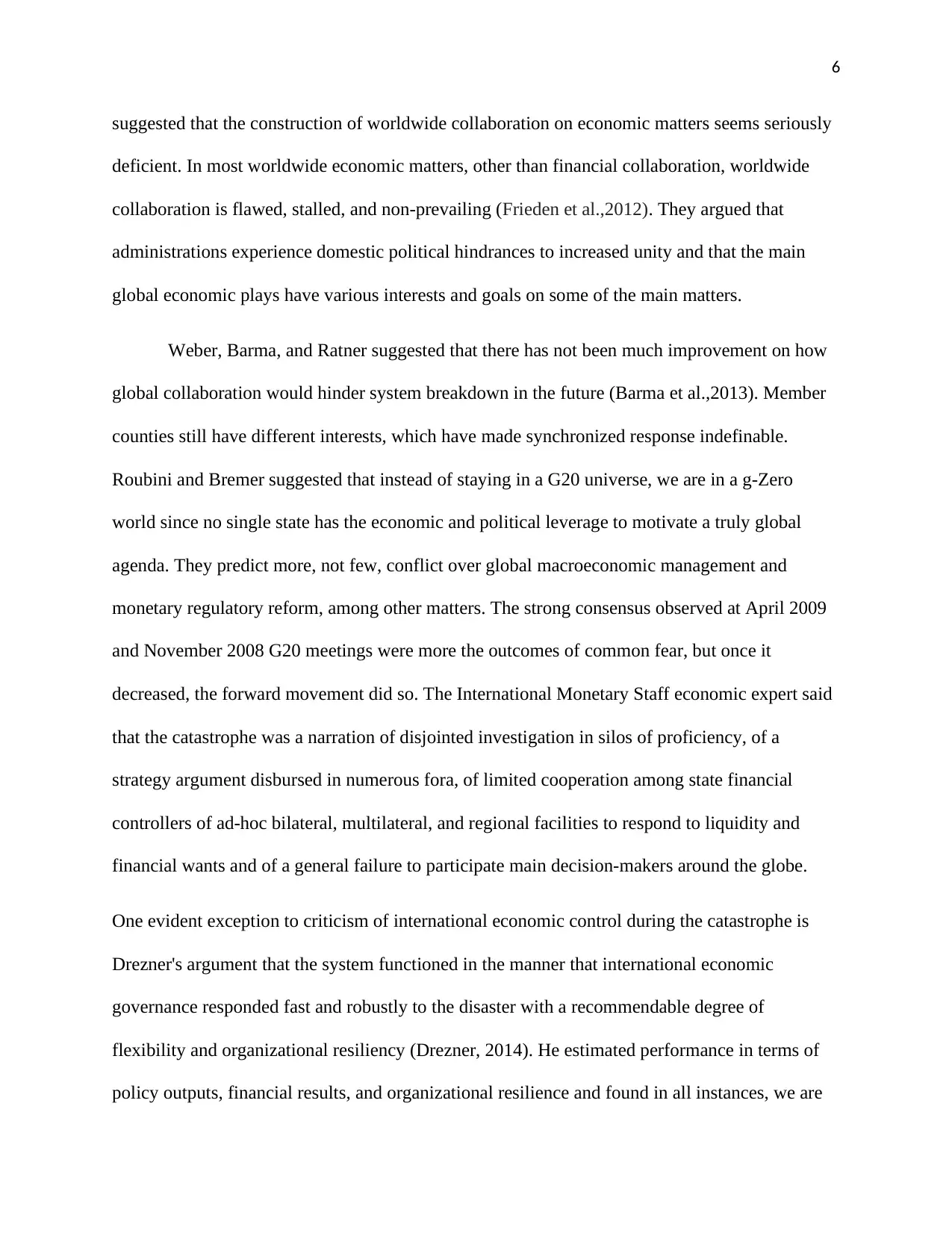
6
suggested that the construction of worldwide collaboration on economic matters seems seriously
deficient. In most worldwide economic matters, other than financial collaboration, worldwide
collaboration is flawed, stalled, and non-prevailing (Frieden et al.,2012). They argued that
administrations experience domestic political hindrances to increased unity and that the main
global economic plays have various interests and goals on some of the main matters.
Weber, Barma, and Ratner suggested that there has not been much improvement on how
global collaboration would hinder system breakdown in the future (Barma et al.,2013). Member
counties still have different interests, which have made synchronized response indefinable.
Roubini and Bremer suggested that instead of staying in a G20 universe, we are in a g-Zero
world since no single state has the economic and political leverage to motivate a truly global
agenda. They predict more, not few, conflict over global macroeconomic management and
monetary regulatory reform, among other matters. The strong consensus observed at April 2009
and November 2008 G20 meetings were more the outcomes of common fear, but once it
decreased, the forward movement did so. The International Monetary Staff economic expert said
that the catastrophe was a narration of disjointed investigation in silos of proficiency, of a
strategy argument disbursed in numerous fora, of limited cooperation among state financial
controllers of ad-hoc bilateral, multilateral, and regional facilities to respond to liquidity and
financial wants and of a general failure to participate main decision-makers around the globe.
One evident exception to criticism of international economic control during the catastrophe is
Drezner's argument that the system functioned in the manner that international economic
governance responded fast and robustly to the disaster with a recommendable degree of
flexibility and organizational resiliency (Drezner, 2014). He estimated performance in terms of
policy outputs, financial results, and organizational resilience and found in all instances, we are
suggested that the construction of worldwide collaboration on economic matters seems seriously
deficient. In most worldwide economic matters, other than financial collaboration, worldwide
collaboration is flawed, stalled, and non-prevailing (Frieden et al.,2012). They argued that
administrations experience domestic political hindrances to increased unity and that the main
global economic plays have various interests and goals on some of the main matters.
Weber, Barma, and Ratner suggested that there has not been much improvement on how
global collaboration would hinder system breakdown in the future (Barma et al.,2013). Member
counties still have different interests, which have made synchronized response indefinable.
Roubini and Bremer suggested that instead of staying in a G20 universe, we are in a g-Zero
world since no single state has the economic and political leverage to motivate a truly global
agenda. They predict more, not few, conflict over global macroeconomic management and
monetary regulatory reform, among other matters. The strong consensus observed at April 2009
and November 2008 G20 meetings were more the outcomes of common fear, but once it
decreased, the forward movement did so. The International Monetary Staff economic expert said
that the catastrophe was a narration of disjointed investigation in silos of proficiency, of a
strategy argument disbursed in numerous fora, of limited cooperation among state financial
controllers of ad-hoc bilateral, multilateral, and regional facilities to respond to liquidity and
financial wants and of a general failure to participate main decision-makers around the globe.
One evident exception to criticism of international economic control during the catastrophe is
Drezner's argument that the system functioned in the manner that international economic
governance responded fast and robustly to the disaster with a recommendable degree of
flexibility and organizational resiliency (Drezner, 2014). He estimated performance in terms of
policy outputs, financial results, and organizational resilience and found in all instances, we are
⊘ This is a preview!⊘
Do you want full access?
Subscribe today to unlock all pages.

Trusted by 1+ million students worldwide

7
in a worse state and sometimes in a good state than at the high level of crisis. International
economic development, foreign direct investment, and trade flow all rebound. His evidence
comprised the rapid response by finance ministries, central bank, IMF, and the G20 in 2008-
2009. He also observed Germany's decision to implement a big fiscal stimulus, which had not
been its former preference, to sign strategic coordination.
The International Monetary Fund was not the main player right when the market imploded. As
observed, this catastrophe was not instantly about emerging markets or other developing nations,
the IMF's major clients. Moreover, the IMF did poor work of raising any red flag during its
surveillance ahead of the disaster. It did not expect the disaster. It did observe that the housing
prices were unstable in most developed economies. Still, it responded that the crisis happened; it
predicted stable situations since it did not understand what would occur to financial institutions
like banks if the housing prices took a sharp descending turn. In April 2007, its International
Economic Outlook concluded that dangers to the universal economy were very low (Joyce,
2012). This was the period when the American housing bubble has already exploded, declines in
sales had increased, the American subprime mortgage calamity started to affect wider credit
markets. The WEO reported that the biggest American subprime lender, New century financial,
filed for bankruptcy securities with over $100 million liabilities in the same month. The big
financial organizations were reporting large sum losses by the end of the year, mostly because
they held securities connected to subprime mortgages.
For instance, the IMF appeared to recognize some risks, weakening members about the possible
effect of international imbalances on the dollar. But even where danger was recognized, the
information was not effective. The information was delivered in broad terms, without analyzing
the scale of the issues or the harshness of their possible effect. The associated sanguine general
in a worse state and sometimes in a good state than at the high level of crisis. International
economic development, foreign direct investment, and trade flow all rebound. His evidence
comprised the rapid response by finance ministries, central bank, IMF, and the G20 in 2008-
2009. He also observed Germany's decision to implement a big fiscal stimulus, which had not
been its former preference, to sign strategic coordination.
The International Monetary Fund was not the main player right when the market imploded. As
observed, this catastrophe was not instantly about emerging markets or other developing nations,
the IMF's major clients. Moreover, the IMF did poor work of raising any red flag during its
surveillance ahead of the disaster. It did not expect the disaster. It did observe that the housing
prices were unstable in most developed economies. Still, it responded that the crisis happened; it
predicted stable situations since it did not understand what would occur to financial institutions
like banks if the housing prices took a sharp descending turn. In April 2007, its International
Economic Outlook concluded that dangers to the universal economy were very low (Joyce,
2012). This was the period when the American housing bubble has already exploded, declines in
sales had increased, the American subprime mortgage calamity started to affect wider credit
markets. The WEO reported that the biggest American subprime lender, New century financial,
filed for bankruptcy securities with over $100 million liabilities in the same month. The big
financial organizations were reporting large sum losses by the end of the year, mostly because
they held securities connected to subprime mortgages.
For instance, the IMF appeared to recognize some risks, weakening members about the possible
effect of international imbalances on the dollar. But even where danger was recognized, the
information was not effective. The information was delivered in broad terms, without analyzing
the scale of the issues or the harshness of their possible effect. The associated sanguine general
Paraphrase This Document
Need a fresh take? Get an instant paraphrase of this document with our AI Paraphraser
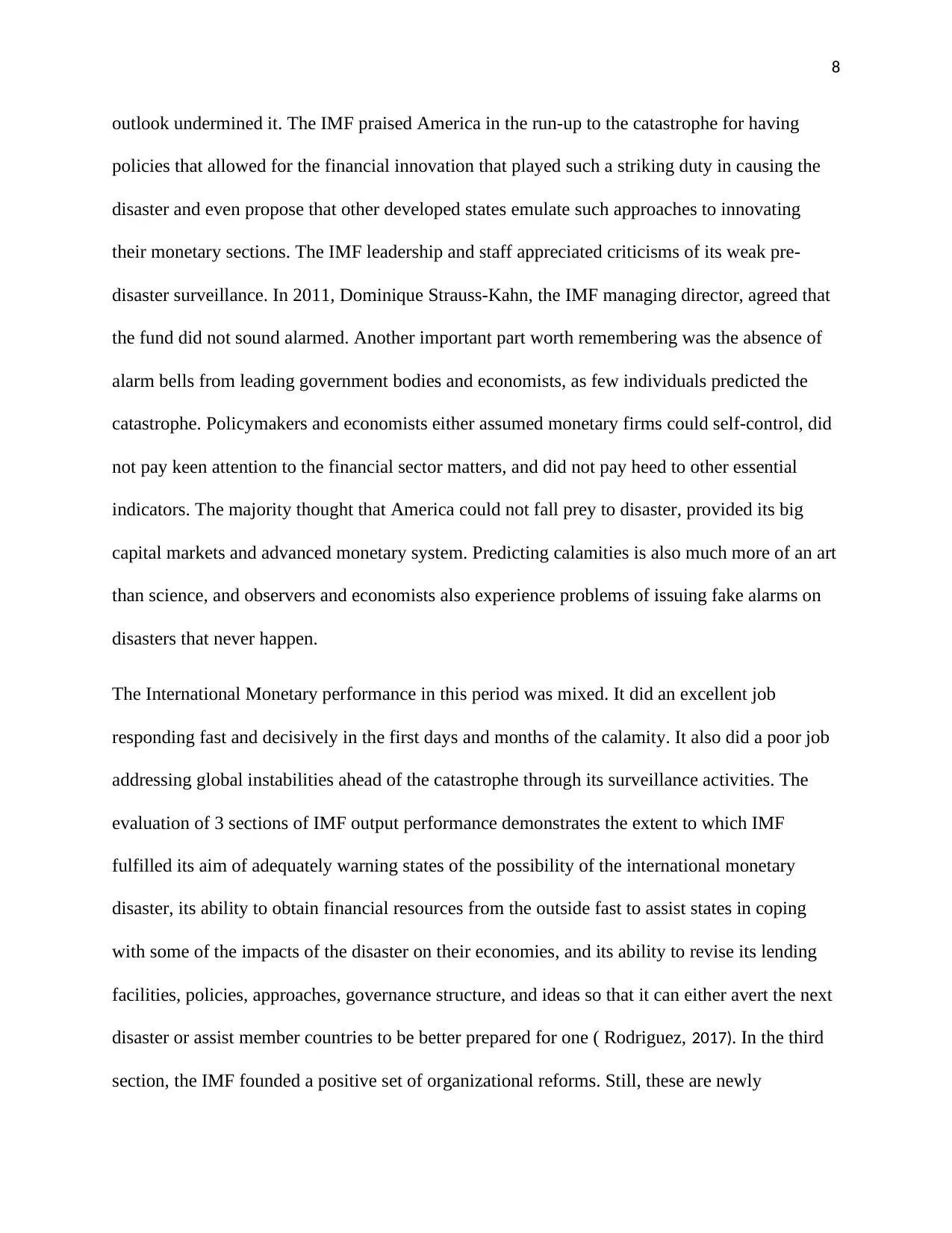
8
outlook undermined it. The IMF praised America in the run-up to the catastrophe for having
policies that allowed for the financial innovation that played such a striking duty in causing the
disaster and even propose that other developed states emulate such approaches to innovating
their monetary sections. The IMF leadership and staff appreciated criticisms of its weak pre-
disaster surveillance. In 2011, Dominique Strauss-Kahn, the IMF managing director, agreed that
the fund did not sound alarmed. Another important part worth remembering was the absence of
alarm bells from leading government bodies and economists, as few individuals predicted the
catastrophe. Policymakers and economists either assumed monetary firms could self-control, did
not pay keen attention to the financial sector matters, and did not pay heed to other essential
indicators. The majority thought that America could not fall prey to disaster, provided its big
capital markets and advanced monetary system. Predicting calamities is also much more of an art
than science, and observers and economists also experience problems of issuing fake alarms on
disasters that never happen.
The International Monetary performance in this period was mixed. It did an excellent job
responding fast and decisively in the first days and months of the calamity. It also did a poor job
addressing global instabilities ahead of the catastrophe through its surveillance activities. The
evaluation of 3 sections of IMF output performance demonstrates the extent to which IMF
fulfilled its aim of adequately warning states of the possibility of the international monetary
disaster, its ability to obtain financial resources from the outside fast to assist states in coping
with some of the impacts of the disaster on their economies, and its ability to revise its lending
facilities, policies, approaches, governance structure, and ideas so that it can either avert the next
disaster or assist member countries to be better prepared for one ( Rodriguez, 2017). In the third
section, the IMF founded a positive set of organizational reforms. Still, these are newly
outlook undermined it. The IMF praised America in the run-up to the catastrophe for having
policies that allowed for the financial innovation that played such a striking duty in causing the
disaster and even propose that other developed states emulate such approaches to innovating
their monetary sections. The IMF leadership and staff appreciated criticisms of its weak pre-
disaster surveillance. In 2011, Dominique Strauss-Kahn, the IMF managing director, agreed that
the fund did not sound alarmed. Another important part worth remembering was the absence of
alarm bells from leading government bodies and economists, as few individuals predicted the
catastrophe. Policymakers and economists either assumed monetary firms could self-control, did
not pay keen attention to the financial sector matters, and did not pay heed to other essential
indicators. The majority thought that America could not fall prey to disaster, provided its big
capital markets and advanced monetary system. Predicting calamities is also much more of an art
than science, and observers and economists also experience problems of issuing fake alarms on
disasters that never happen.
The International Monetary performance in this period was mixed. It did an excellent job
responding fast and decisively in the first days and months of the calamity. It also did a poor job
addressing global instabilities ahead of the catastrophe through its surveillance activities. The
evaluation of 3 sections of IMF output performance demonstrates the extent to which IMF
fulfilled its aim of adequately warning states of the possibility of the international monetary
disaster, its ability to obtain financial resources from the outside fast to assist states in coping
with some of the impacts of the disaster on their economies, and its ability to revise its lending
facilities, policies, approaches, governance structure, and ideas so that it can either avert the next
disaster or assist member countries to be better prepared for one ( Rodriguez, 2017). In the third
section, the IMF founded a positive set of organizational reforms. Still, these are newly
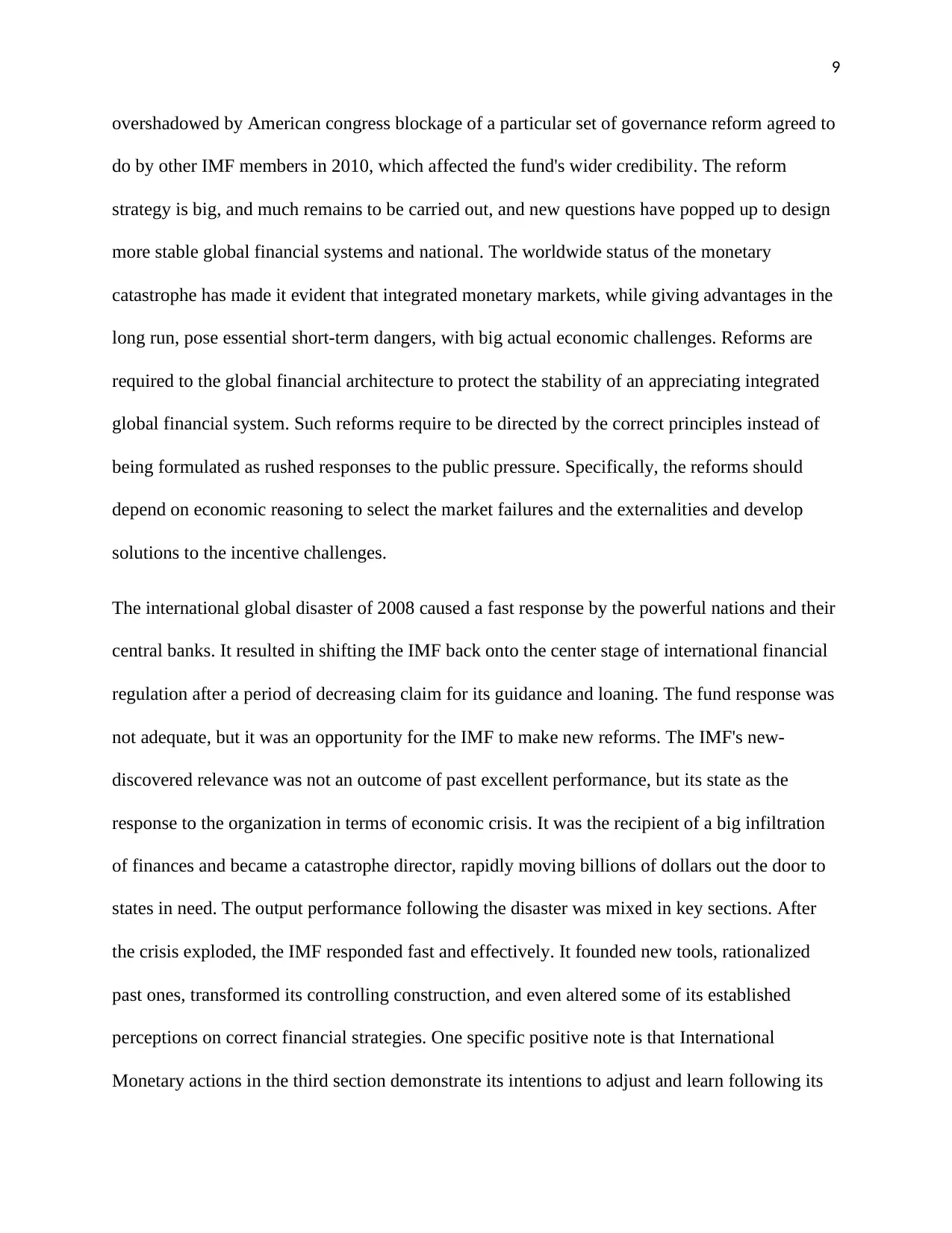
9
overshadowed by American congress blockage of a particular set of governance reform agreed to
do by other IMF members in 2010, which affected the fund's wider credibility. The reform
strategy is big, and much remains to be carried out, and new questions have popped up to design
more stable global financial systems and national. The worldwide status of the monetary
catastrophe has made it evident that integrated monetary markets, while giving advantages in the
long run, pose essential short-term dangers, with big actual economic challenges. Reforms are
required to the global financial architecture to protect the stability of an appreciating integrated
global financial system. Such reforms require to be directed by the correct principles instead of
being formulated as rushed responses to the public pressure. Specifically, the reforms should
depend on economic reasoning to select the market failures and the externalities and develop
solutions to the incentive challenges.
The international global disaster of 2008 caused a fast response by the powerful nations and their
central banks. It resulted in shifting the IMF back onto the center stage of international financial
regulation after a period of decreasing claim for its guidance and loaning. The fund response was
not adequate, but it was an opportunity for the IMF to make new reforms. The IMF's new-
discovered relevance was not an outcome of past excellent performance, but its state as the
response to the organization in terms of economic crisis. It was the recipient of a big infiltration
of finances and became a catastrophe director, rapidly moving billions of dollars out the door to
states in need. The output performance following the disaster was mixed in key sections. After
the crisis exploded, the IMF responded fast and effectively. It founded new tools, rationalized
past ones, transformed its controlling construction, and even altered some of its established
perceptions on correct financial strategies. One specific positive note is that International
Monetary actions in the third section demonstrate its intentions to adjust and learn following its
overshadowed by American congress blockage of a particular set of governance reform agreed to
do by other IMF members in 2010, which affected the fund's wider credibility. The reform
strategy is big, and much remains to be carried out, and new questions have popped up to design
more stable global financial systems and national. The worldwide status of the monetary
catastrophe has made it evident that integrated monetary markets, while giving advantages in the
long run, pose essential short-term dangers, with big actual economic challenges. Reforms are
required to the global financial architecture to protect the stability of an appreciating integrated
global financial system. Such reforms require to be directed by the correct principles instead of
being formulated as rushed responses to the public pressure. Specifically, the reforms should
depend on economic reasoning to select the market failures and the externalities and develop
solutions to the incentive challenges.
The international global disaster of 2008 caused a fast response by the powerful nations and their
central banks. It resulted in shifting the IMF back onto the center stage of international financial
regulation after a period of decreasing claim for its guidance and loaning. The fund response was
not adequate, but it was an opportunity for the IMF to make new reforms. The IMF's new-
discovered relevance was not an outcome of past excellent performance, but its state as the
response to the organization in terms of economic crisis. It was the recipient of a big infiltration
of finances and became a catastrophe director, rapidly moving billions of dollars out the door to
states in need. The output performance following the disaster was mixed in key sections. After
the crisis exploded, the IMF responded fast and effectively. It founded new tools, rationalized
past ones, transformed its controlling construction, and even altered some of its established
perceptions on correct financial strategies. One specific positive note is that International
Monetary actions in the third section demonstrate its intentions to adjust and learn following its
⊘ This is a preview!⊘
Do you want full access?
Subscribe today to unlock all pages.

Trusted by 1+ million students worldwide
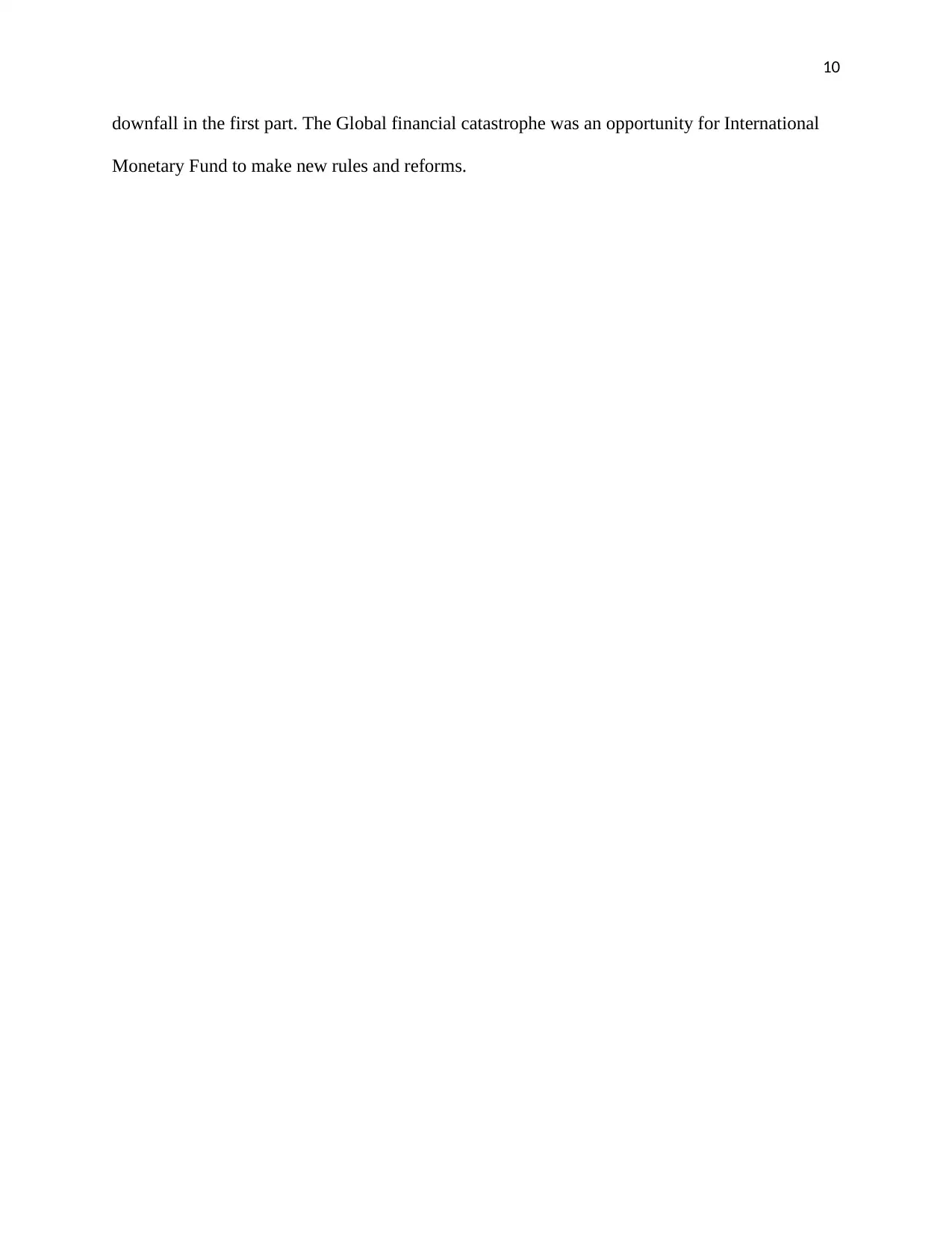
10
downfall in the first part. The Global financial catastrophe was an opportunity for International
Monetary Fund to make new rules and reforms.
downfall in the first part. The Global financial catastrophe was an opportunity for International
Monetary Fund to make new rules and reforms.
Paraphrase This Document
Need a fresh take? Get an instant paraphrase of this document with our AI Paraphraser
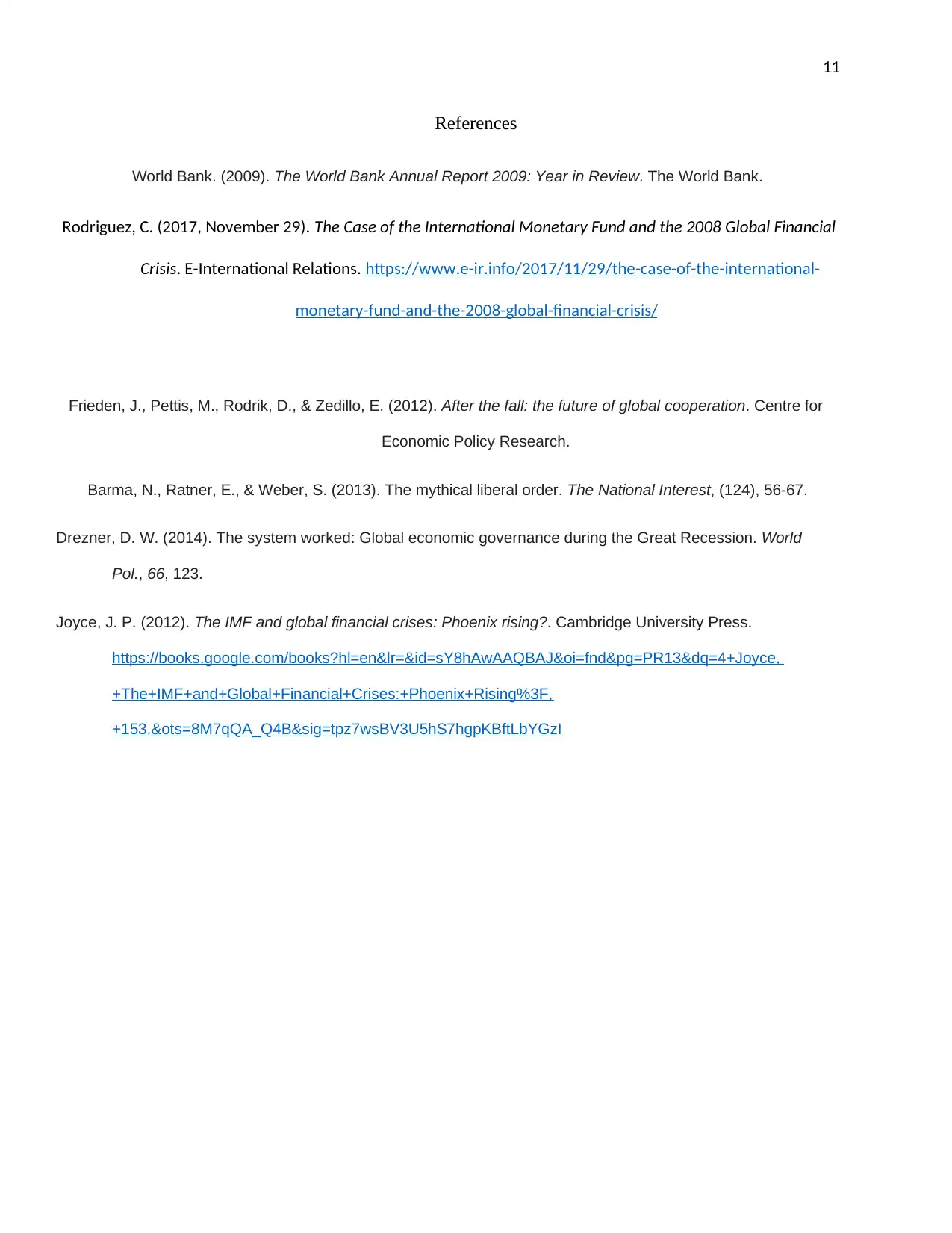
11
References
World Bank. (2009). The World Bank Annual Report 2009: Year in Review. The World Bank.
Rodriguez, C. (2017, November 29). The Case of the International Monetary Fund and the 2008 Global Financial
Crisis. E-International Relations. https://www.e-ir.info/2017/11/29/the-case-of-the-international-
monetary-fund-and-the-2008-global-financial-crisis/
Frieden, J., Pettis, M., Rodrik, D., & Zedillo, E. (2012). After the fall: the future of global cooperation. Centre for
Economic Policy Research.
Barma, N., Ratner, E., & Weber, S. (2013). The mythical liberal order. The National Interest, (124), 56-67.
Drezner, D. W. (2014). The system worked: Global economic governance during the Great Recession. World
Pol., 66, 123.
Joyce, J. P. (2012). The IMF and global financial crises: Phoenix rising?. Cambridge University Press.
https://books.google.com/books?hl=en&lr=&id=sY8hAwAAQBAJ&oi=fnd&pg=PR13&dq=4+Joyce,
+The+IMF+and+Global+Financial+Crises:+Phoenix+Rising%3F,
+153.&ots=8M7qQA_Q4B&sig=tpz7wsBV3U5hS7hgpKBftLbYGzI
References
World Bank. (2009). The World Bank Annual Report 2009: Year in Review. The World Bank.
Rodriguez, C. (2017, November 29). The Case of the International Monetary Fund and the 2008 Global Financial
Crisis. E-International Relations. https://www.e-ir.info/2017/11/29/the-case-of-the-international-
monetary-fund-and-the-2008-global-financial-crisis/
Frieden, J., Pettis, M., Rodrik, D., & Zedillo, E. (2012). After the fall: the future of global cooperation. Centre for
Economic Policy Research.
Barma, N., Ratner, E., & Weber, S. (2013). The mythical liberal order. The National Interest, (124), 56-67.
Drezner, D. W. (2014). The system worked: Global economic governance during the Great Recession. World
Pol., 66, 123.
Joyce, J. P. (2012). The IMF and global financial crises: Phoenix rising?. Cambridge University Press.
https://books.google.com/books?hl=en&lr=&id=sY8hAwAAQBAJ&oi=fnd&pg=PR13&dq=4+Joyce,
+The+IMF+and+Global+Financial+Crises:+Phoenix+Rising%3F,
+153.&ots=8M7qQA_Q4B&sig=tpz7wsBV3U5hS7hgpKBftLbYGzI
1 out of 11
Related Documents
Your All-in-One AI-Powered Toolkit for Academic Success.
+13062052269
info@desklib.com
Available 24*7 on WhatsApp / Email
![[object Object]](/_next/static/media/star-bottom.7253800d.svg)
Unlock your academic potential
Copyright © 2020–2025 A2Z Services. All Rights Reserved. Developed and managed by ZUCOL.





